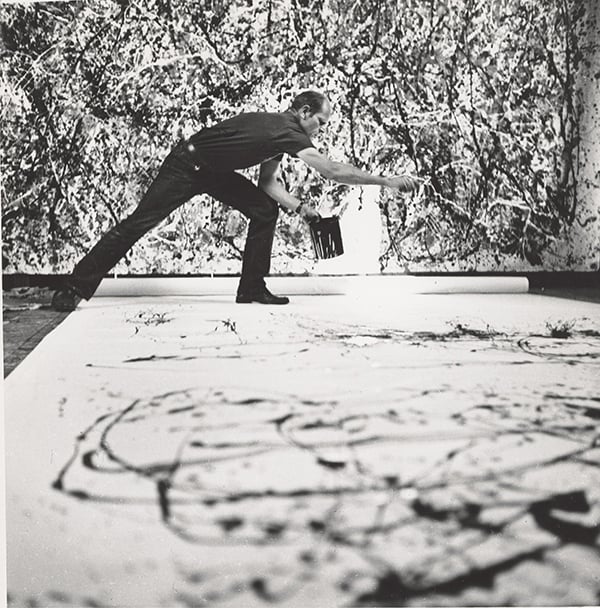Pollock
came
out of the West
a
mamma's boy who
hung on
apron strings
never
cut
he
became a child of
the
alcoholic NY City night
his
brothers took care of him
as
did Benton's wife
(and
the W.P.A.)
and
other women who
mothered
him
and
then his wife
who
thought he could do no wrong
she
promoted him
and
he became
phenomenon
perhaps
the greatest painter
in
America
sneered
LIFE magazine
perhaps
not
he
did not know
himself
chump
or champ
after
all the drips
had
dried
he
could not break through
again
to
anything nearly as creative
as
those colorful splatters
he
went black & white
then
figurative
again
and
ever deeper into frustration
and
on a public-suicide trip
(no
one called him on his shit)
that
finally succeeded
at
sixty mph
the
final splatter
(he
took someone with him,
he
never could stand to be alone)
they
buried him six feet under
then
pulled a huge boulder over
so
that
he
could not crawl back up.

Jackson Pollock at work in 1950 -- Hans Namuth
Jackson Pollock was born in Cody, Wyoming, in 1912. When he was 10 months old his mother took him and his 4 older brothers to San Diego, California, and he grew up in California and Arizona. He moved to New York in 1930 and studied painting at the Art Students League under Thomas Hart Benton, a self-proclaimed "enemy of modernism," who, along with his wife Rita Piacenza Benton, took a keen interest in his welfare and remained close for decades. In true Oedipal fashion, Pollock even fell in love with Benton's wife. Pollock once remarked that Benton "had come face-to-face with Michelangelo and lost” and often said that Benton's traditional teachings gave him something to rebel against, though he was clearly influenced by the older artist's rhythmic use of paint and his organizational scheme, vertical rows wrapped in swirls of form. Perhaps most significantly, Pollock claimed the only thing he learned from his mentor was how to drink a fifth of whiskey a day. Years later, in 1968, Benton recalled, "Although ... Jack’s talents seemed of a most minimal order, I sensed he was some kind of artist. I had learned anyhow that great talents were not the most essential requirements for artistic success.” He also once proclaimed that "Jack never made a painting that wasn't beautiful."
ReplyDeleteFrom 1938 to 1942 Pollock worked for the Works Progress Administration's Federal Art Project. The WPA was the New Deal's largest agency, employing millions of people to carry out public works projects, and its Federal Art Project provided work for some 10,000 artists and craftsmen. Mexican muralist David Alfaro Siqueiros had already introduced him to the use of liquid paint in 1936, and around 1947 he tried to paint a stampede of horses, but he lost control of the painting because he lacked the discipline and skill to execute a figurative mural, so, out of anger, he started slinging paint onto the canvas to create the driving, swirling action and thrust the composition and the heroic size demanded. This accident led to his "drip period" (1947-1950) in which he placed unstretched raw canvas on the floor where it could be attacked from all sides with art materials and industrial materials dripped and thrown. His abstract expressionism was highlighted in a 4-page spread in "Life" magazine in 1949 which asked, "Is he the greatest living painter in the United States?" Before his fame, in 1942 he met fellow abtractionist Lee Krasner, and they married in 1945. At The Springs, a farmhouse on the outskirts of East Hampton on the south shore of Long Island, he painted in a barn in their backyard while she worked in an upstairs bedroom. After he abandoned his drip technique, she used her superior knowledge and training in modern art and techniques to shape his approach and improve his saleability. Although she never stopped painting, she frequently destroyed her work as she experimented with new styles, so little of her work from the time she was associated with Pollock has survived; often she did not sign her paintings, or she signed them with the genderless initials "L.K.", or she blended her signature into the painting itself. Pollock did his last 2 paintings in 1955 and began working on wire and plaster sculpture in 1956. On 11 August 1956, while Lee was vacationing in Europe, at 10:15 PM, after a day and sleepless night of intense binge drinking followed by another full day of gin, Pollock drove his green 1950 Oldsmobile 88 convertible off Springs-Fireplace Road into a tree, less than a mile from his home. Artist Ruth Kligman, Pollock’s mistress and the former lover of Willem de Kooning, survived. But the life of her friend Edith Metzger ended standing in the backseat of the convertible, screaming that she wanted to get out of the car as it flipped end over end. Pollock died instantly upon impact. Lee (whom B. H. Friedman bitingly referred to as "Action Widow" in 1972) managed her husband's estate until her death in 1984. The couple are buried in the Green River Cemetery in East Hampton (which became the resting place for many artists and writers including poet Frank O'Hara), with a large boulder marking his grave and a smaller one in front marking hers. Six months later, she became one of only 4 female artists to be given a retrospective show at the Museum of Modern Art in New York. In 2003 "Celebration," a horizontal composition in oil on canvas she painted in 1960, sold for $1.9 million dollars. In contrast, her husband's "Number 11, 1952" was bought for the National Gallery of Australia for $2 million, at the time the highest price ever paid for a modern painting; in 2006 his "No. 5, 1948" became the world's most expensive painting ($140 million), but in 2016 his "Number 17A" (also 1948) brought in $200 million.
ReplyDelete